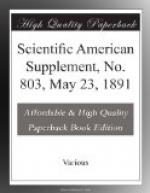The definition herein set forth has not been given in any treatise on the subject, so far as we have been able to ascertain. And it is presented with the distinctly expressed hope that it never will be, except as a mere matter of abstract interest.
Of this it may, like the other, possess a little, but both have the great disadvantage that, except in relation to the parabola, the idea which they convey to the mind of the curves to which they relate, if indeed they convey any at all, is most obscure and indirect; and of practical utility neither one can claim a particle.
* * * * *
TABLE OF ATOMIC WEIGHTS.
(Issued December 6, 1890.)
By request of the Committee of Revision and Publication of the Pharmacopoeia of the United States of America, Prof. F.W. Clarke, chief chemist of the United States Geological Survey, has furnished a table of atomic weights, revised upon the basis of the most recent data and his latest computations. The committee has resolved that this table be printed and furnished for publication to the professional press. The committee also requests that all calculations and analytical data which are to be given in reports or contributions intended for its use or cognizance be based upon the values in the table. It would be highly desirable that this table be adopted and uniformly followed by chemists in general, at least for practical purposes, until it is superseded by a revised edition. It would only be necessary for any author of a paper, etc., to state that his analytical figures are based upon “Prof. Clarke’s table of atomic weights of December 6, 1890,” or some subsequent issue.
This table represents the latest and most trustworthy results, reduced to a uniform basis of comparison, with oxygen=16 as starting point of the system. No decimal places representing large uncertainties are used. When values vary, with equal probability on both sides, so far as our present knowledge goes, as in the case of cadmium (111.8 and 112.2), the mean value is given in the table.
The names of elements occurring in pharmaceutical, medicinal, chemicals, are printed in italics[1]:
[Transcriber’s Note 1: ITALICS represented by surrounding with “".]
Name. Symbol. Atomic Weight.
Aluminum. Al 27. Antimony. Sb 120. Arsenic. As 75. Barium. Ba 137. Bismuth. Bi 208.9 Boron. B 11. Bromine. Br 79.95 Cadmium. Cd 112. Caesium. Cs 132.9 Calcium. Ca 40. Carbon. C 12. Cerium. Ce 140.2 Chlorine. Cl 35.45




